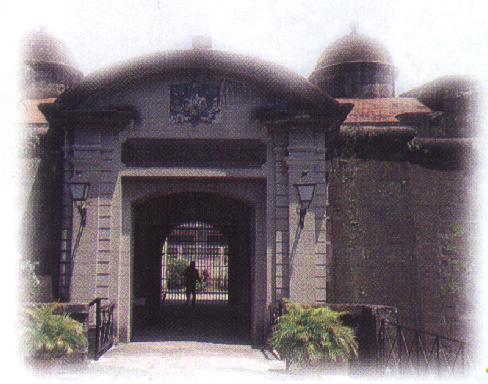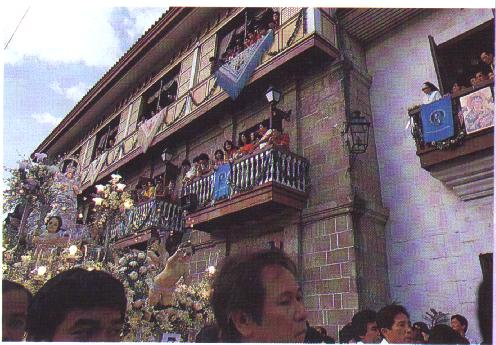OLD MANILA


On these stone walls, our nation’s story is etched. A longtime resident of the Walled City, in an interview with national artist Nick Joaquin, expressed it succinctly: "From the Intramuros of my childhood, there are two strands of memory: Intramuros in peacetime and Intramuos in wartime; one a memory of tranquility, the other of fear and destruction."
Indeed, our memories of Old Manila vacillate between two extremes.
The fountain of Plaza del Moriones and the verdant lawn of Plaza de armas (in present-day Fort Santiago) evoke a genteel era: the faint music of tertulias (afternoon musicals), señoritos and señoritas whiling away the siesta hours with piano recitals and sips of hot chocolate eh.
But the Soldier’s Barracks, the dungeon and the baluartes tell a different tale altogether.
Visible on the whitewashed walls of the Soldier’s Barracks are bulletholes–souvenirs from the British invasion of Manila in 1762.
Unmindful of the bullet-riddled walls, lovers congregate in the nearby picnic grove, while recorded rondolla (folkloric band not unlike Mexico’s Mariachi) music play in the background. (There are fifteen tables in the picnic grove. During the summer, concerts, with the AFP Band, are held at the Plaza Moriones, fronting the picnic grove.)

HALL OF HORRORS
Welcome to the dungeon.
Beneath the Baluarte de San Barbara is the dungeon, otherwise known as the hall of horrors.
To enter, one must pass through an opening less than four feet high. Once inside, one is engulfed by a sense of dread; the walls of the dungeon seem to reverberate with the silent screams of tortured souls.
In one of the numerous archeological diggings within the Fort, they stumbled upon six hundred bones of American and Filipino soldiers from the Second World War. The skeletons have since been blessed and buried in a common gravesite (marked with a white cross) inside the Fort.
Stories of prisoners being left to drown, whenever Pasig River’s waters overflowed into the dungeon during high tide, are mercifully false because the dank walls absorb water. The dungeon is filled with mud puddles; rain water had obviously seeped through the floors and walls.
Still there was a more insidious form of torture inflicted on Filipinos by foreign invaders: the skylight in the dungeon was not meant to let the sunshine in. The prisoners were left exposed to the elements, left to die under the sun, in the rain.
From tertulias
to orture, such is the strange odyssey of the City of Man.
OTHERWORLDLY RESIDENTS
Because of its colorful (and bloody) past, spectral sightings have become commonplace in the Walled City.
Members of the Philippine Educational Theater Association (PETA)-which mounts its socially relevant plays inside the Fort, at the rajah Sulayman Theater-have had numerous encounters with the Fort’s restless spirits.
There have been tales of props disappearing and reappearing at the last minute, of shrieks being heard by actors rehearsing late in the night, of a clammy hand brushing the back of their necks in the dressing room.
Casa Manila, in the Plaza San Luis complex along Gen. Luna St., has its share of otherwordly residents.
Envisioned as a "living museum," Casa Manila was constructed from 1981 to 1983, to recreate the ambience of a 19th century residence in Calle de Jaboneros, Binondo.
Guards at the Casa have reportedly heard mysterious footsteps in the empty staircase and azotea (roof garden). Employees and foreign guests have complained about dark shadows in the utility room, of the toilet flushing by itself, of a bearded European gentleman in frock coat and top hat disappearing in the dining room, and of a middle-aged Spanish mestiza floating in the museum.
A British furniture restorer once actually witnessed poltergeist activity in the basement workshop: a bottle of acetone flitted from table to table.
These hauntings people attribute to the skeletons found in a well uncovered in the course of archeological diggings. The bones could have been of Filipinos who hid in the well during World War II, or of corpses duped by American GIs.
Casa Manila was
blessed by a priest, the Gaceta de Intramuros reported in 1990. Since then,
the ghostly manifestations have decreased in frequency, but have not ceased
altogether.

INTRAMUROS, CIRCA 1900'S
The ghosts of Intramuros are not limited to the spectral sort.
The rattling chains and tremulous moans can also serve as metaphors for disturbing traumas buried in the collective unconcious.
In a Gaceta article, oldtimers mourned the death of Intramuros after the Walled City was razed in 1945.
Intramuros, circa
1900s, was an idyllic reverie. Elderly gentlemen singled out bustling Real
Street with its myriad bazaars, restaurants, hat stores, bars, dance halls,
bookstores and shoe-shine stands.
Excerpts from the article of Bayani S. San Diego, Jr. in Mabuhay.